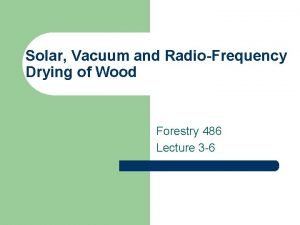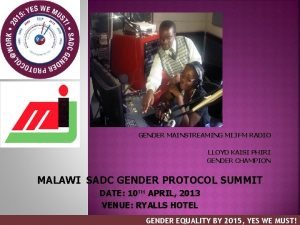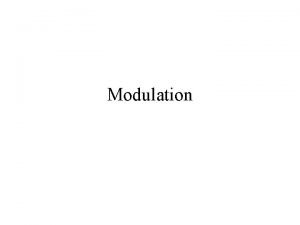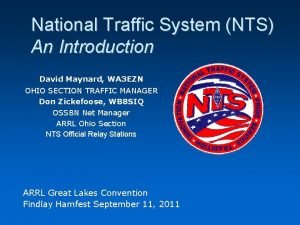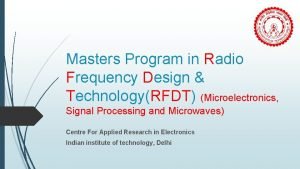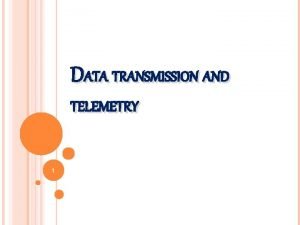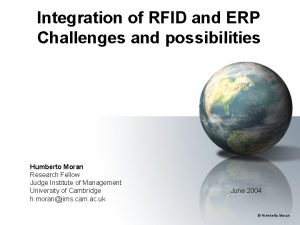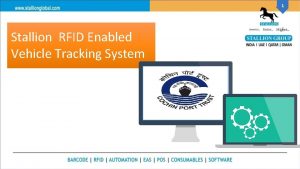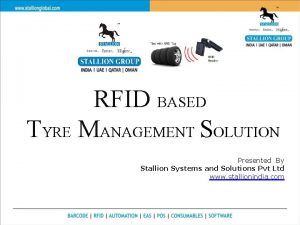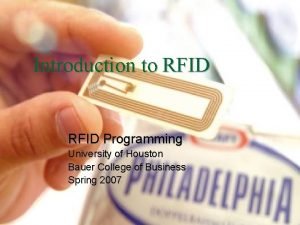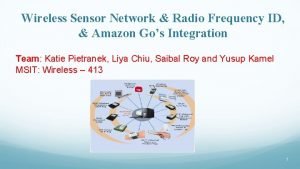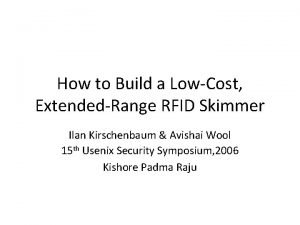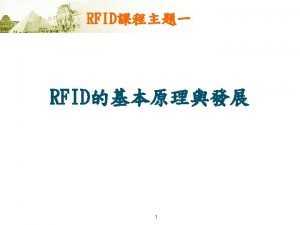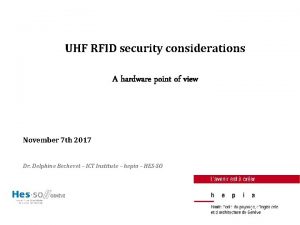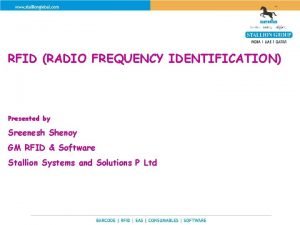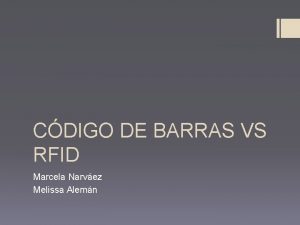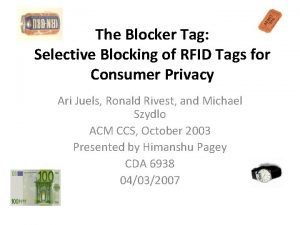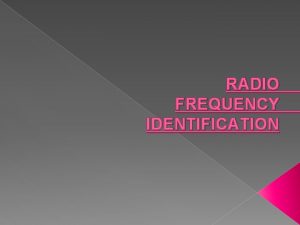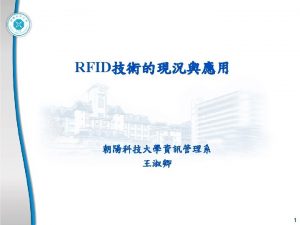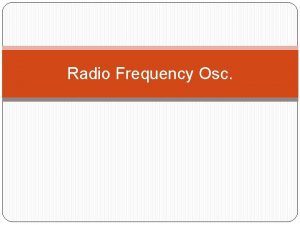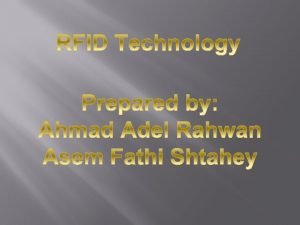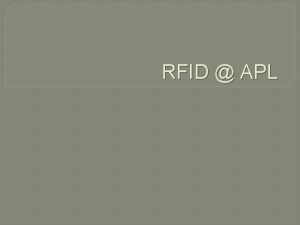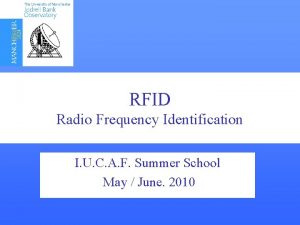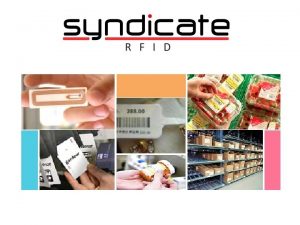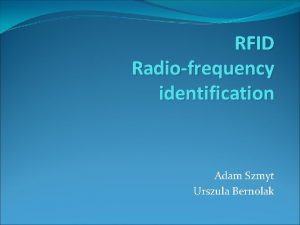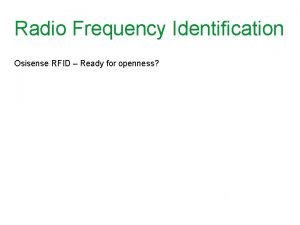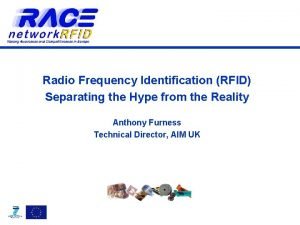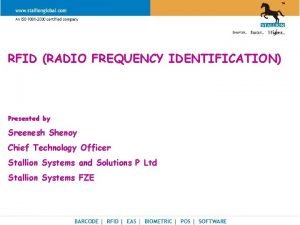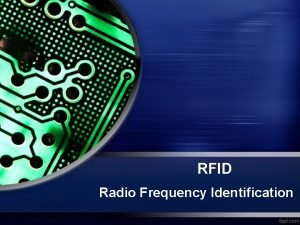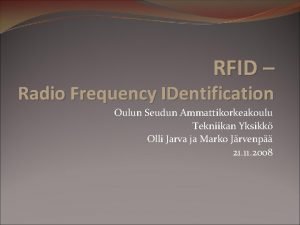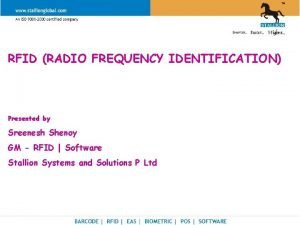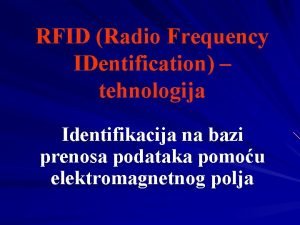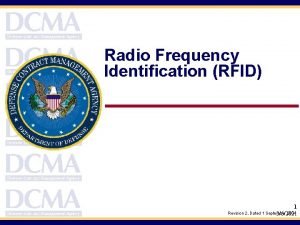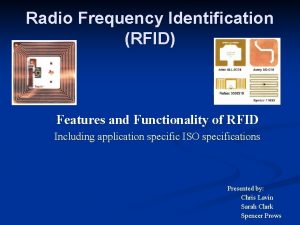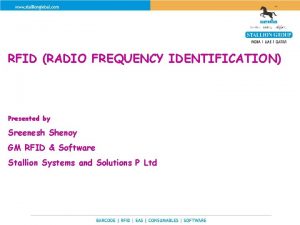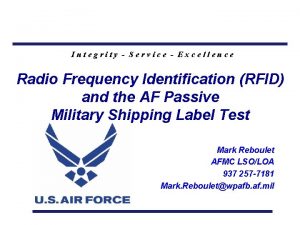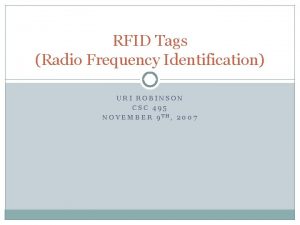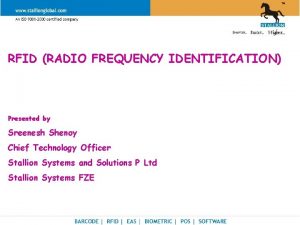RFID RADIO FREQUENCY IDENTIFICATION What is RFID Radiofrequency






































- Slides: 38

RFID RADIO FREQUENCY IDENTIFICATION

What is RFID? Radio-frequency identification (RFID) is an automatic identification method using radio waves. RFID also began to see use in wildlife monitoring and research. RFID tags can be used to monitor animal movement without adversely affecting the animal,

There’s a chip

Implanted RFID tags in Humans

Applications Ø Ø Ø Ø Ø Supply chain automation Asset tracking Medical applications People tracking Manufacturing Retail Warehouses Livestock Timing

The RFID System 1. 2. 3. 4. 5. 6. Tag. Reader antenna. Controller. Host and software system. Communication infrastructure.

Tag An RFID tag is a device that can store and transmit data to a reader in a contact less manner using radio waves. RFID tags can be classified in three different ways. Passive

Passive Tag Ø No on-board power source (for example, a battery) Ø Uses the power emitted from the reader to energize itself and transmit its stored data to the reader Ø Reader always communicates first, followed by the tag.

Ø Smaller than an active or semi-active tag. It has a variety of read ranges starting with less than 1 inch to about 30 feet (9 meters approximately). Ø Cheaper compared to an active or semi-active tag.

Tag An RFID tag is a device that can store and transmit data to a reader in a contactless manner using radio waves. RFID tags can be classified in three different ways. Passive Active

Active Tag Ø Has on-board power source (for example, a battery; other sources of power, such as solar, are also possible) Ø Own on-board power supply to transmit its data to a reader. Ø No need for reader's emitted power for data transmission.

Ø A tag always communicates first, followed by the reader. Ø Can broadcast its data to its surroundings even in the absence of a reader

Tag An RFID tag is a device that can store and transmit data to a reader in a contactless manner using radio waves. RFID tags can be classified in three different ways. Passive Active Semi-Active (Semi-Passive) Tags

Semi-Active (Semi-Passive) Tags Ø Ø Have an on-board power source (for example, a battery) Uses the reader's emitted power for transmitting its data Also called a battery-assisted tag. Reader always communicates first, followed by the tag.

Another way to Classify Tags Ø Read-only (RO) Ø Write once, read many (WORM) Ø Read-write (RW)

The RFID System 1. 2. 3. 4. 5. 6. Tag. Reader antenna. Controller. Host and software system. Communication infrastructure.

Reader? ? ØAn RFID reader can read from and write data to compatible RFID tags. ØA reader thus doubles up as a writer. The act of writing the tag data by a reader is called creating a tag.

A reader has the following main components: ØTransmitter ØReceiver ØMicroprocessor ØMemory ØController (which may reside as an external component) ØCommunication interface ØPower

Working A radio device called a tag is attached to the object that needs to be identified. When this tagged object is presented in front of a suitable RFID reader, the tag transmits this data to the reader (via the reader antenna). The reader then reads the data and has the capability to forward it over suitable communication channels. This application can then use this unique data to identify the object presented to the reader. It can then perform a variety of actions


Backscatter modulation? Ø A common way the communication between a tag and a reader Ø Reader sends a signal (energy) to a tag, and the tag responds by reflecting a part of this energy back to the reader. Ø A charge device such as a capacitor contained in the tag makes this reflection possible. Ø The capacitor gets charged as it stores the energy received from the reader. Ø As the tag responds back, it uses this energy to send the signal back to the reader. The capacitor discharges in the process.

Reader Tag Interaction

Ø A tag consist of a dipole antenna attached to an interdigital transducer (IDT) placed on a piezoelectric substrate. Ø A series of well-placed individual electrodes acting as reflectors are positioned on the substrate. Ø The antenna applies an electrical impulse to the IDT when it receives the RF signal from a reader. Ø Some of these waves are reflected back to the IDT by the reflectors; the rest are absorbed by the substrate. Ø The reflected waves form a unique pattern, determined by the reflector positions, representing the tag data. Ø These waves are converted back to the RF signal in the IDT and transmitted back to the RFID reader via the tag antenna. Ø The reader then decodes the received signal to extract the tag data.

Software private void Form 1_Load(object sender, Event. Args e) { rfid 1 = new RFID(); rfid 1. Attach += new Attach. Event. Handler(rfid_Attach); rfid 1. Detach += new Detach. Event. Handler(rfid_Detach); rfid 1. RFIDTag += new Tag. Event. Handler(rfid_Tag); rfid 1. RFIDTag. Lost += new Tag. Event. Handler(rfid_Tag. Lost); rfid 1. open(); }

Design

Software Contd. private void antenna. Check. Box_Checked. Changed(object sender, Event. Args e) { rfid 1. Antenna = cbox. Antenna. Checked; }

Software Contd. void rfid_Attach(object sender, Attach. Event. Args e) { Phidgets. RFID phid = (Phidgets. RFID)sender; lbl. Attached. Text = " Attached: " + phid. Name; lbl. Serial. Text = " Serial: " + phid. Serial. Number; lbl. Version. Text = " Version: " + phid. Version; } void rfid_Detach(object sender, Detach. Event. Args e) { lbl. Attached. Text = "Not Attached"; }

Software Contd. void rfid_Tag(object sender, Tag. Event. Args e) { txt. Tag. Text = e. Tag; last. RFIDTag = txt. Tag. Text; rfid 1. LED = true; // light on } void rfid_Tag. Lost(object sender, Tag. Event. Args e) { txt. Tag. Text = ""; rfid 1. LED = false; // light off lb. Prev. RFIDTags. Items. Insert(0, string. Format("Tag: {0} - {1}", ++Tag. Ctr, last. RFIDTag)); }

After reading Tags.

Frequency ØLF band: 125 and 135 k. Hz--LF generally use passive tags ØHF band 3 MHz to 30 MH ØTypical Frequency: 13. 56 MHz--HF system uses passive tags. ØHF systems are also widely used, especially in hospitals ØThese frequency bands can be used freely worldwide.

Frequency Contd. Ø UHF band: 300 MHz to 1 GHz Ø Typical Frequency : 915 MHz--Uses both active and passive tags Ø MW band>1 GHz Ø Typical Frequency: 2. 4 GHz or 5. 8 GHz—Uses Semi active and passive tags.

Technical Issues Ø Ø Tag Collision Reader Collision Tag Readability Read Robustness

Ethical Issues Ø Passive RFID tags could conceivably used for surveillance of unsuspecting tag carriers Ø Embedding of RFID tags in humans: This has been proven to work, but should it be done?

Advantages Contactless. An RFID tag can be read without any physical contact between the tag and the reader. Writable data. The data of a read-write (RW) RFID tag can be rewritten a large number of times. Absence of line of sight. A line of sight is generally not required for an RFID reader to read an RFID tag.

Advantages Contd. Ø Ø Variety of read ranges. Wide data-capacity range. Support for multiple tag reads. Perform smart tasks.

Disadvantages Ø Poor performance with RF-opaque and RF-absorbent objects. Ø Impacted by environmental factors. Ø Limitation on actual tag reads. Ø Impacted by hardware interference.

CONCLUSION Ø RFID, is an emerging technology which can be used for a variety of applications. Ø However, the potential for abuse of this technology is vast and requires careful consideration to avoid.

Questions? ? ? ? ?
 Radio frequency identification
Radio frequency identification Radio frequency identification
Radio frequency identification Presumptive identification vs positive identification
Presumptive identification vs positive identification Trunked radio vs conventional radio
Trunked radio vs conventional radio Vacuum rf kiln
Vacuum rf kiln Radio frequency antenna
Radio frequency antenna Radio frequency quadrupole
Radio frequency quadrupole Radio haanji
Radio haanji Radio haanji dial to listen number
Radio haanji dial to listen number Mij fm
Mij fm Fm radio frequency
Fm radio frequency Nts radio frequency
Nts radio frequency Radio frequency design and technology
Radio frequency design and technology Data transmission and telemetry
Data transmission and telemetry Joint frequency
Joint frequency Vmax shm
Vmax shm Frequency vs relative frequency
Frequency vs relative frequency Observed frequency
Observed frequency Joint relative frequency
Joint relative frequency Marginal frequency distribution
Marginal frequency distribution Angular frequency to frequency
Angular frequency to frequency Rfid erp
Rfid erp Rfid vehicle tracking system
Rfid vehicle tracking system Rfid marathon tracking
Rfid marathon tracking Library automation using rfid project
Library automation using rfid project Rfid and business intelligence
Rfid and business intelligence Rfid tyre management system
Rfid tyre management system Rifd readers houston
Rifd readers houston Rfid reader block diagram
Rfid reader block diagram Disadvantages of rfid in libraries
Disadvantages of rfid in libraries Rfid skimmer
Rfid skimmer Rfid tagsource
Rfid tagsource Rfid antenna
Rfid antenna Rfid school
Rfid school American apparel rfid case study
American apparel rfid case study Codigo de barras vs rfid
Codigo de barras vs rfid Rfid and business intelligence
Rfid and business intelligence Rajasthan state road transport corporation
Rajasthan state road transport corporation Benetton rfid
Benetton rfid




